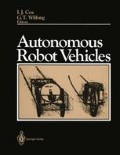Abstract
This paper presents a unique real-time obstacle avoidance approach for manipulators and mobile robots based on the artificial potential field concept. Collision avoidance, traditionally considered a high level planning problem, can be effectively distributed between different levels of control, allowing real-time robot operations in a complex environment. This method has been extended to moving obstacles by using a time-varying artificial potential field. We have applied this obstacle avoidance scheme to robot arm mechanisms and have used a new approach to the general problem of real-time manipulator control. We reformulated the manipulator control problem as direct control of manipulator motion in operational space—the space in which the task is originally described—rather than as control of the task’s corresponding joint space motion obtained only after geometric and kinematic transformation. Outside the obstacles’ regions of influence, we caused the end effector to move in a straight line with an upper speed limit. The artificial potential field approach has been extended to collision avoidance for all manipulator links. In addition, a joint space artificial potential field is used to satisfy the manipulator internal joint constraints. This method has been implemented in the COSMOS system for a PUMA 560 robot. Real-time collision avoidance demonstrations on moving obstacles have been performed by using visual sensing.
Access this chapter
Tax calculation will be finalised at checkout
Purchases are for personal use only
Preview
Unable to display preview. Download preview PDF.
References
Brooks, R. 1983. Solving the find-path problem by good representation of free space. IEEE Sys., Man Cyber. SMC-13: 190–197.
Brooks, R. 1984 Aug. 20–23, Kyoto, Japan. Aspects of mobile robot visual map making. 2nd Int. Symp. Robotics Res.
Buckley, C. 1985. The application of continuum methods to path planning. Ph.D. Thesis (in progress). Stanford University, Department of Mechanical Engineering.
Chatila, R. 1981. Système de navigation pour un robot mobile autonome: modélisation et processus décisionnels. Thèse de Docteur-Ingénieur. Université Paul Sabatier. Toulouse, France.
Hogan, N. 1984 June 6–8, San Diego, California. Impedance control: an approach to manipulation. 1984 Amer. Control Conf.
Khatib, O., Llibre, M. and Mampey, R. 1978. Fonction decision-commande d’un robot manipulateur. Rapport No. 2/7156. DERA/CERT. Toulouse, France.
Khatib, O. and Le Maitre, J. F. 1978 September 12–15, Udine, Italy. Dynamic control of manipulators operating in a complex environment. Proc. 3rd CISM-IFToMM Symp. Theory Practice Robots Manipulators, 267–282. Elsevier. 1979.
Khatib, O. 1980. Commande dynamique dans l’espace opérationnel des robots manipulateurs en présence d’obstacles. These de Docteur-Ingénieur. École Nationale Supérieure de l’Aéronautique et de l’Espace ( ENSAE ). Toulouse, France.
Khatib, O. 1983 December 15–20, New Delhi. Dynamic control of manipulators in operational space. 6th CISM-IFToMM Congress Theory Machines Mechanisms, 1128–1131.
Khatib, O., et al. 1984 June, Robotics in three acts (Film). Stanford University. Artificial Intelligence Laboratory.
Khatib, O. 1985 September 11–13, Tokyo. The operational space formulation in robot manipulators control. 15th Int. Symp. Indust. Robots.
Khatib, O. and Burdick, J. 1985 November, Miami, Florida. Dynamic optimization in manipulator design: the operational space formulation. ASME Winter Annual Meeting.
Khatib, O., Burdick, J., and Armstrong, B. 1985. Robotics in three acts-Part II (Film). Stanford University, Artificial Intelligence Laboratory.
Krogh, B. 1984 August, Bethlehem, Pennsylvania. A generalized potential field approach to obstacle avoidance control. SME Conf. Proc. Robotics Research: The Next Five Years and Beyond.
Kuntze, H. B., and Schill, W. 1982 June 9–11, Paris. Methods for collision avoidance in computer controlled industrial robots. 12th ISIR.
Lozano-Perez, T. 1980. Spatial planning: a configuration space approach. AI Memo 605. Cambridge, Mass. MIT Artificial Intelligence Laboratory.
Moravec, H. P. 1980. Obstacle avoidance and navigation in the real world by a seeing robot rover. Ph.D. Thesis. Stanford University, Artificial Intelligence Laboratory.
Author information
Authors and Affiliations
Editor information
Editors and Affiliations
Rights and permissions
Copyright information
© 1986 Massachusetts Institute of Technology
About this chapter
Cite this chapter
Khatib, O. (1986). Real-Time Obstacle Avoidance for Manipulators and Mobile Robots. In: Cox, I.J., Wilfong, G.T. (eds) Autonomous Robot Vehicles. Springer, New York, NY. https://doi.org/10.1007/978-1-4613-8997-2_29
Download citation
DOI: https://doi.org/10.1007/978-1-4613-8997-2_29
Publisher Name: Springer, New York, NY
Print ISBN: 978-1-4613-8999-6
Online ISBN: 978-1-4613-8997-2
eBook Packages: Springer Book Archive

